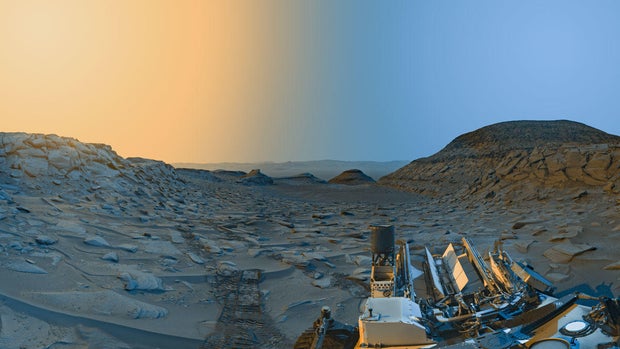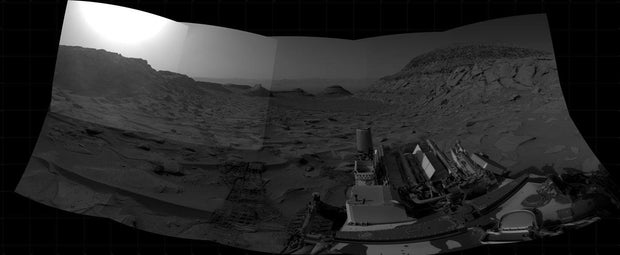NASA's Mars rover, Curiosity, recently captured a stunning photo of the Martian skies and landscape that offers researchers a glimpse at what the red planet looks like at different times of day.
The rover, which has been on Mars since August 2012, captured the images with black-and-white navigation cameras on April 8, 2023, NASA said in a news release. The rover took photos in the morning and afternoon, and sent them back to researchers on Earth.
Once in the hands of NASA scientists, the photos were turned into panoramic images. Color was also added to the photos, creating what NASA referred to as a "postcard," and further emphasizing the difference between the two times the photos were taken.
The panoramic postcard shows a number of Mars landmarks, including "Marker Band Valley," where Curiosity once found evidence that there may have been a lake on the site, and two hills named "Bolivar" and "Deepdale." At the edge of the photo is the rim of the Gale Crater, which Curiosity is currently exploring. Because the photograph was taken on a clear day, Curiosity's image even shows a mountain that is 54 miles from the edge of the crater.
The photo also shows Curiosity itself and captures the rover's tracks across the dusty Martian landscape.
Even more impressive than the landscape photography is what it teaches researchers about the way the sun and shadows move on Mars.
"Anyone who's been to a national park knows the scene looks different in the morning than it does in the afternoon," said Curiosity engineer Doug Ellison of NASA's Jet Propulsion Laboratory in Southern California, who planned and processed the images, in a second news release. "Capturing two times of day provides dark shadows because the lighting is coming in from the left and the right, like you might have on a stage – but instead of stage lights, we're relying on the sun."
Images without the added color remain striking: The black-and-white photos each show the same scene, but with deepening shadows on each side. In the morning images, the shadows are on the left.
In the afternoon photos, the shadows come from the right side, and the entire image appears darker.
NASA noted that it was winter at the time the rover took these photos. During this time of the year on Mars, shadows are deeper and darker because dust levels in the Martian atmosphere are at their lowest.
"Mars' shadows get sharper and deeper when there's low dust and softer when there's lots of dust," Ellison said.
The Curiosity rover, which is the size of an SUV, is working to search for conditions, past or present, favorable for life on the planet. The rover was built by NASA's Jet Propulsion Laboratory, which manages Curiosity's mission.
Article From & Read More ( NASA's Curiosity rover sends "postcard" showing Mars during different times of the day - CBS News )https://ift.tt/DOLFnfR
Science





No comments:
Post a Comment